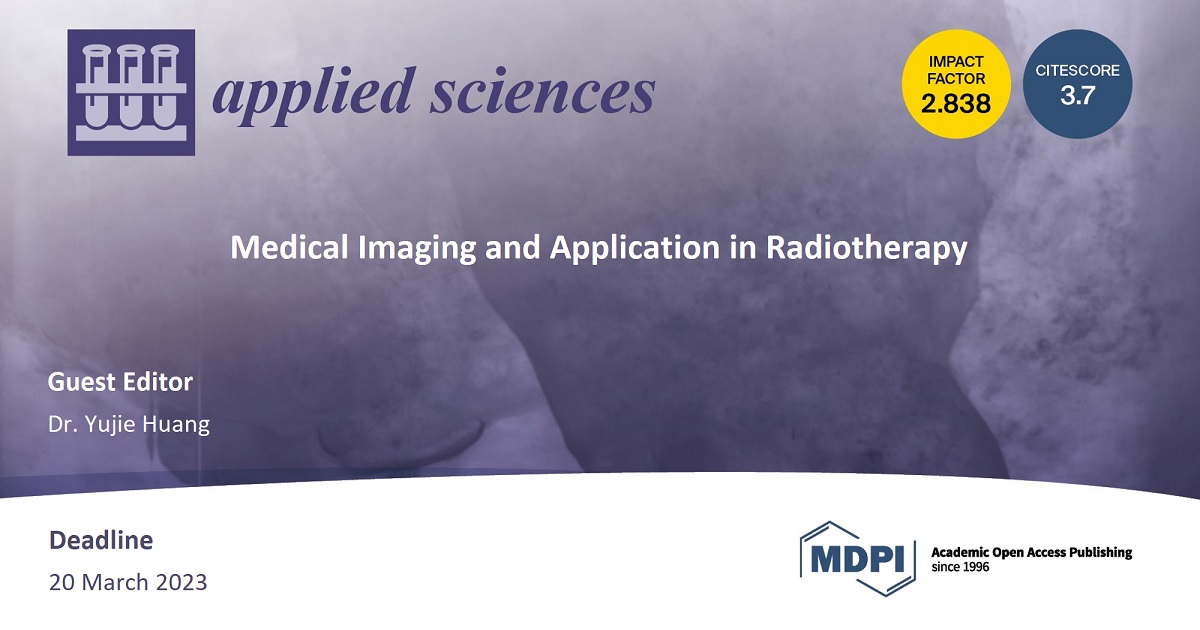Medical Imaging and Application in Radiotherapy
A special issue of Applied Sciences (ISSN 2076-3417). This special issue belongs to the section "Applied Biosciences and Bioengineering".
Deadline for manuscript submissions: closed (20 March 2023) | Viewed by 7533

Special Issue Editor
Interests: radiotherapy; intensity-modulated radiotherapy; IMRT; radiation oncology; radiation therapy; stereotactic radiosurgery; radiosurgery; radiation biology
Special Issues, Collections and Topics in MDPI journals
Special Issue Information
Dear Colleagues,
Since 1895, with the discovery of radiation by Roentgen, it has been used to treat diseases. Up to now, radiation has been one of the major modalities to treat cancer. Radiation therapy has developed from the treatment field and was drawn on a plane film to computerized 3-dimensional volumetric treatment plan. Advances in medical imaging have played an indispensable role. High-quality radiation therapy relies on precise localization to deliver radiation within the body and accurate radiation dose calculation. The localization of the lesion for treatment depends on delicate medical imaging for geometric information, and electron density of tissues for radiation dose calculation. Image guidance is also an important issue when the patient lies on a couch for treatment. These are all about medical imaging for radiation therapy.
This Special Issue is proposed to reveal the medical imaging and application in radiotherapy. Architectures may include, but are not limited to, medical imaging applications for cancer treatment, novel concurrent algorithms and applications for radiation therapy dose calculation, medical imaging for treatment target delineation, radiation therapy treatment plan optimization, image guidance, treatment response evaluation by medical imaging, respiratory motion in medical imaging, and anything about radiation therapy. Artificial intelligence applications, computer assistance, and quality assurance in radiation therapy are also topics of interest.
This Special Issue will publish high-quality, original research papers in the overlapping fields of:
- Medical imaging;
- Radiation therapy;
- Target delineation;
- Medical image registration;
- Radiation dose calculation;
- Radiation treatment planning optimization;
- Image guidance;
- Respiratory control;
- Treatment response by medical imaging;
- Computer assistance radiotherapy;
- Quality assurance in radiotherapy.
Dr. Yujie Huang
Guest Editor
Manuscript Submission Information
Manuscripts should be submitted online at www.mdpi.com by registering and logging in to this website. Once you are registered, click here to go to the submission form. Manuscripts can be submitted until the deadline. All submissions that pass pre-check are peer-reviewed. Accepted papers will be published continuously in the journal (as soon as accepted) and will be listed together on the special issue website. Research articles, review articles as well as short communications are invited. For planned papers, a title and short abstract (about 250 words) can be sent to the Editorial Office for assessment.
Submitted manuscripts should not have been published previously, nor be under consideration for publication elsewhere (except conference proceedings papers). All manuscripts are thoroughly refereed through a single-blind peer-review process. A guide for authors and other relevant information for submission of manuscripts is available on the Instructions for Authors page. Applied Sciences is an international peer-reviewed open access semimonthly journal published by MDPI.
Please visit the Instructions for Authors page before submitting a manuscript. The Article Processing Charge (APC) for publication in this open access journal is 2400 CHF (Swiss Francs). Submitted papers should be well formatted and use good English. Authors may use MDPI's English editing service prior to publication or during author revisions.
Keywords
- medical imaging
- radiation
- radiotherapy
- target delineation
- image registration
- radiation dose calculation
- optimization
- image guidance
- respiratory control
- treatment response
- quality assurance
- computer assistance
Benefits of Publishing in a Special Issue
- Ease of navigation: Grouping papers by topic helps scholars navigate broad scope journals more efficiently.
- Greater discoverability: Special Issues support the reach and impact of scientific research. Articles in Special Issues are more discoverable and cited more frequently.
- Expansion of research network: Special Issues facilitate connections among authors, fostering scientific collaborations.
- External promotion: Articles in Special Issues are often promoted through the journal's social media, increasing their visibility.
- Reprint: MDPI Books provides the opportunity to republish successful Special Issues in book format, both online and in print.
Further information on MDPI's Special Issue policies can be found here.





